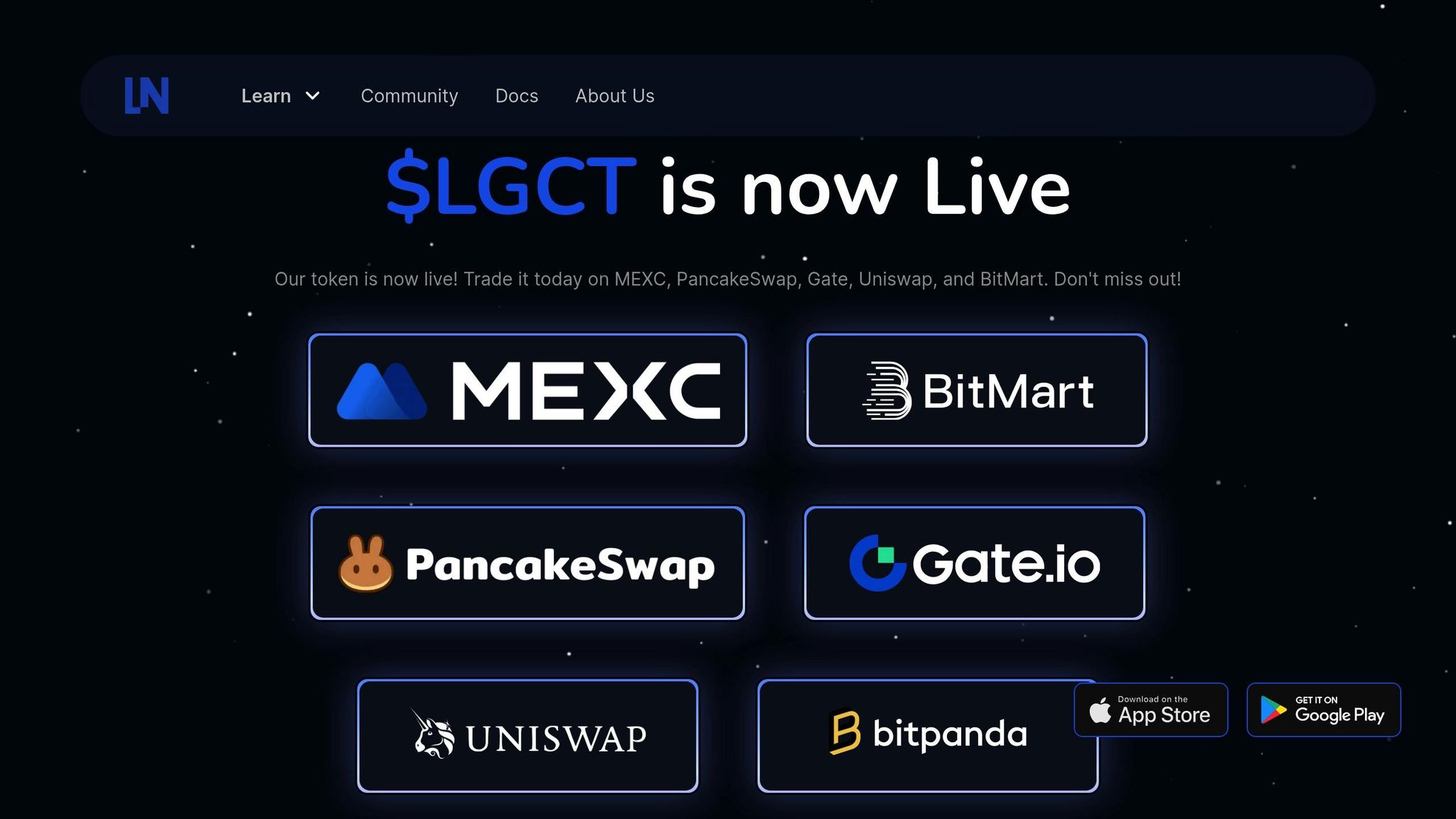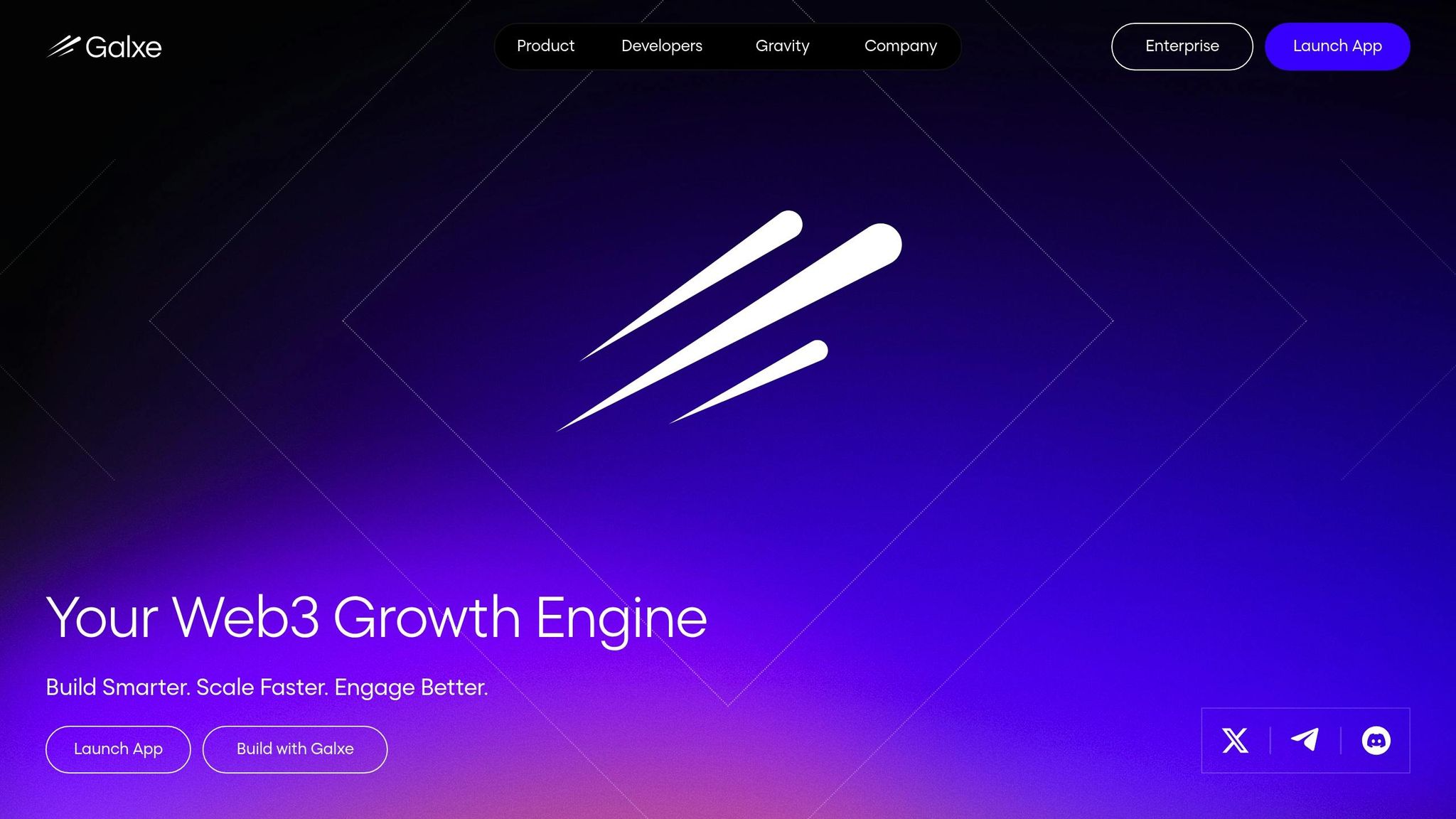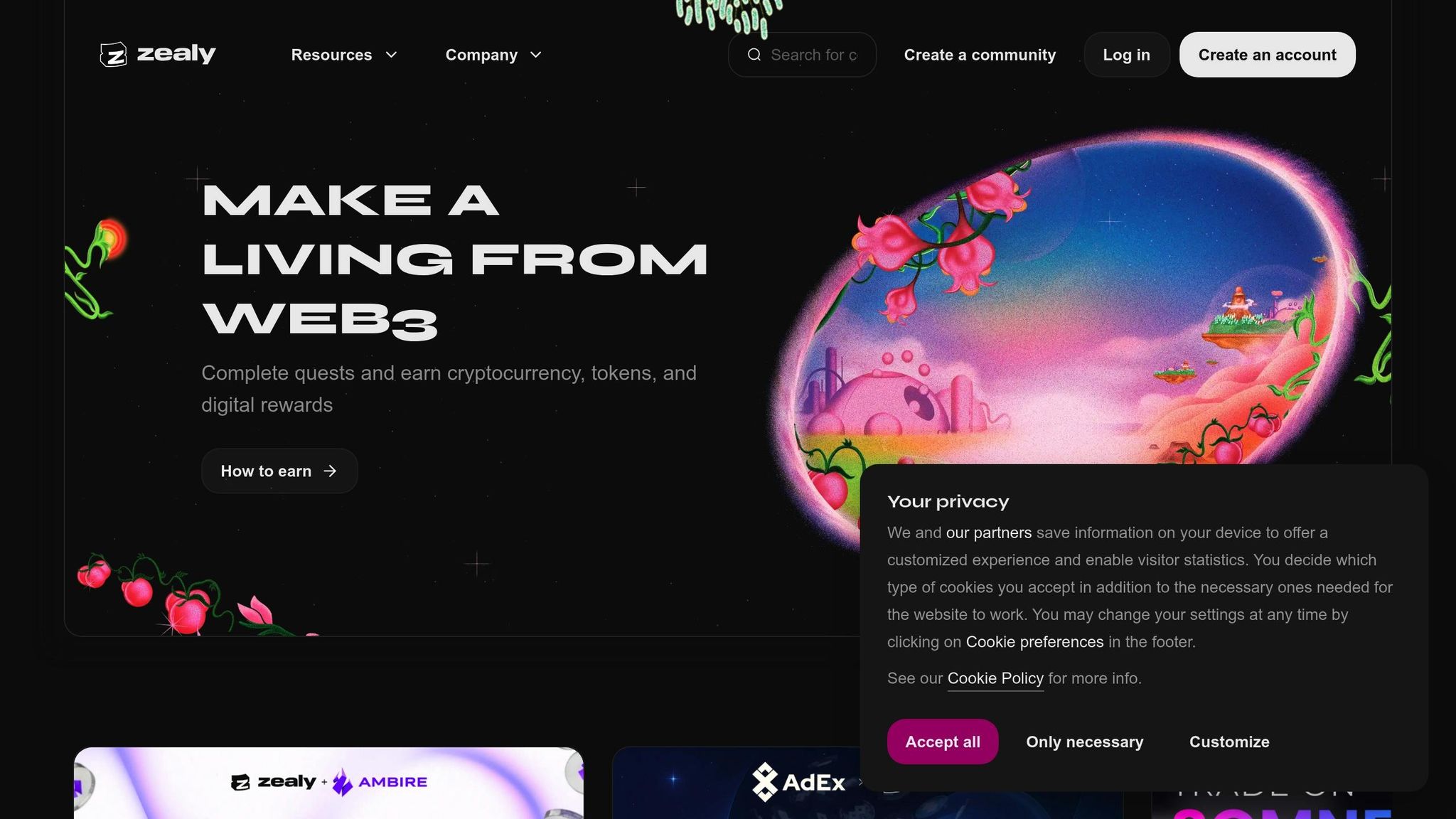Web3 Gamification Trends in Education 2025
Explore how Web3 gamification is revolutionizing education with blockchain, AI, and immersive technologies for engaging learning experiences.

Web3 gamification is reshaping education by combining blockchain, AI, and immersive technologies to create engaging learning experiences. Unlike past systems that relied on basic badges and points, today’s platforms offer tools like NFTs for credentials, smart contracts for rewards, and decentralized achievement tracking. These advancements allow learners to showcase verified skills and accomplishments across platforms.
Key Highlights:
- Upskillist: Focuses on skill-building with tokenized rewards and NFT certifications. AI personalizes learning while keeping blockchain features simple for users.
- Galxe: Uses blockchain for credentialing and quest-driven learning. Offers on-chain verification and smart contracts for automated rewards.
- Zealy: Community-driven platform with quest-based tasks. Prioritizes mastery and social interaction over token incentives.
The global gamification education market is projected to grow from $1.55 billion in 2025 to $18.63 billion by 2033. Each platform has strengths and challenges, from accessibility and technical complexity to engagement and scalability. The right choice depends on specific educational goals and user needs.
Legacy Network: Bridging Gamified Learning and Web3 with $LGCT

1. Upskillist

Upskillist takes a hands-on approach to Web3 gamification, weaving tokenized rewards, NFT certifications, and decentralized achievement tracking into its courses. This setup creates an intuitive learning experience, helping students build skills without needing prior knowledge of crypto. By focusing on simplicity and practicality, Upskillist sets the stage for advanced personalization and automation in its features.
The platform’s gamification strategy revolves around meaningful progression. Students can earn digital badges and tokens by completing modules, tackling challenges, or excelling in their performance. These credentials aren’t just for show - they’re verifiable and can be displayed on-chain, making them valuable for potential employers or educational institutions.
What really sets Upskillist apart is its use of AI to personalize learning. Its adaptive system adjusts course difficulty, suggests challenges, and unlocks rewards based on individual progress, ensuring every student gets a tailored experience.
Upskillist also incorporates traditional gamification elements like points, badges, and leaderboards but takes it a step further by issuing tamper-proof, NFT-based credentials. These are managed and validated through smart contracts, adding a layer of trust and security.
The results speak for themselves. In recent pilot programs, students engaging in tokenized learning quests saw a 30% boost in engagement compared to those in non-gamified courses. Completion rates also improved, especially for advanced technical modules, when NFT certificates were introduced.
To make the platform accessible, Upskillist ensures an easy onboarding process with a user-friendly interface, cloud access, mobile compatibility, and step-by-step guides. The Web3 features work quietly in the background, so even those unfamiliar with blockchain technology can participate without any hassle.
Security is another priority. With encrypted storage and user-controlled wallets, students maintain full control over their digital credentials.
Priced at $39.99 per month with a 4-week free trial, Upskillist makes Web3-enhanced education both affordable and practical, delivering real-world value through its innovative approach.
2. Galxe

Galxe is carving out its niche in the Web3 educational space by offering a blockchain-based platform for credentialing and quest-driven learning. Unlike conventional educational systems, Galxe uses on-chain verification and interactive learning quests to reward students with digital credentials that are both verifiable and secure.
One of Galxe's standout features is its ability to support multiple blockchain networks. This flexibility allows educational institutions to choose the blockchain that best meets their needs. The platform's use of smart contracts ensures that rewards are distributed automatically, eliminating the need for manual oversight and adding a layer of transparency. This technical foundation enables institutions to create innovative and engaging learning experiences.
At the heart of Galxe's platform is its quest builder system. This tool lets educators design detailed, step-by-step learning journeys where each milestone is verified on the blockchain. For instance, a computer science course could include coding challenges, peer reviews, and project-based tasks, with students earning XP points, badges, or NFT certificates as they progress.
To combat issues like fake participation and bot activity, Galxe employs advanced anti-fraud systems. These measures ensure that only legitimate learners are awarded credentials. Its gamification model goes beyond basic point accumulation by introducing multi-layered reward structures that keep students motivated over time. As learners achieve milestones, they unlock new quests and gain access to exclusive educational opportunities tied to their verified accomplishments.
Galxe also customizes its platform to align with U.S. localization requirements. For example, it integrates with widely used digital wallets and identity solutions while adhering to U.S. standards for dates (MM/DD/YYYY), currency ($), and measurement systems.
The platform's "learn-to-earn" model gained momentum in 2025, allowing students to earn tokenized rewards for completing educational tasks. Thanks to its cloud-based infrastructure, Galxe manages complex blockchain operations behind the scenes, enabling educational institutions to offer gamified learning without needing in-depth blockchain expertise.
3. Zealy

Zealy takes a different route compared to platforms like Upskillist and Galxe, offering a community-driven approach to Web3 gamified education. It bridges the gap between traditional e-learning and decentralized, community-powered learning experiences. Much like its counterparts, Zealy focuses on boosting engagement by empowering communities. Through quest-based activities and blockchain integration, it crafts educational journeys that resonate with digital-native learners and Web3 enthusiasts alike.
At the heart of Zealy’s platform is a quest system where learners complete structured tasks to earn points and badges. These quests, combined with team challenges, encourage active participation and help reinforce knowledge.
What sets Zealy apart is its emphasis on genuine learning outcomes rather than shallow engagement. Instead of relying on external token rewards, the platform prioritizes mastery and community recognition. This shift addresses some of the key challenges in Web3 education, ensuring a more meaningful experience for learners.
Zealy also integrates smart contracts to automate credential issuance and maintain secure, tamper-proof records of users' progress.
The platform has gained traction as a tool for onboarding in the Web3 space. Decentralized autonomous organizations (DAOs) and DeFi protocols use Zealy to educate and retain their communities. Participants can learn essential processes like wallet setup, staking, and governance participation while earning on-chain badges and tokens as rewards.
Zealy goes a step further by utilizing AI and analytics to personalize learning. Quests are tailored to individual profiles, allowing users to learn at their own pace and focus on areas that align with their interests and skills. This data-driven approach reflects Education 5.0’s vision of adaptive, student-centered learning environments.
By targeting users who are genuinely interested in the subject matter, Zealy ensures that learning outcomes remain meaningful and engagement extends beyond initial rewards. This thoughtful design fosters sustainable participation and long-term value.
Given the global gamification education market is expected to reach $18.63 billion by 2033, Zealy’s approach is well-positioned in this growing industry. Its cloud-based infrastructure not only offers scalability and accessibility but also retains the transparency and security advantages of blockchain technology, making it a compelling choice for educational institutions and Web3 projects alike.
Platform Advantages and Drawbacks
Each Web3 gamification platform has its own set of strengths and challenges when applied in the educational space. The table below outlines the key benefits and limitations of three platforms, followed by a deeper dive into how these factors affect engagement, accessibility, scalability, and more.
| Platform | Key Advantages | Primary Drawbacks |
|---|---|---|
| Upskillist | • Cloud-based delivery ensures easy access • User-friendly and structured learning paths • Focus on practical skills through expert-designed content |
• Lacks blockchain-based gamification • Traditional rewards may lose appeal over time |
| Galxe | • Blockchain-based incentives drive initial engagement • Decentralized platform with global reach |
• Requires managing digital wallets • Risks of bot activity and fake engagement • Steep learning curve for newcomers |
| Zealy | • Community-driven challenges encourage social interaction | • Demands Web3 onboarding knowledge • Risk of user drop-off as reward novelty fades • Technical barriers for crypto beginners |
These pros and cons highlight the unique challenges platforms face in retaining users and ensuring accessibility.
Engagement and Retention Challenges
While the Web3 education market continues to grow, retaining users remains a major hurdle. Platforms that rely on superficial incentives often see drop-off rates as high as 90% when rewards fail to connect meaningfully with learning goals. Upskillist tackles this issue by offering structured, goal-oriented learning paths and ongoing assessments, which help learners develop consistent engagement habits. On the other hand, blockchain-based platforms like Galxe and Zealy, which often depend on token rewards, may struggle to maintain interest once the initial buzz fades.
Technical Complexity and Accessibility Trade-offs
Accessibility varies widely across these platforms. Upskillist stands out for its simplicity - learners only need internet access and basic digital skills to get started. Its cloud-based model supports access on multiple devices without requiring blockchain knowledge or digital wallet setup. In contrast, platforms like Galxe and Zealy demand a higher level of technical understanding, including managing digital wallets and navigating blockchain transactions. This complexity can be a significant barrier, particularly in traditional educational settings where users may lack familiarity with Web3 technologies.
Scalability and Infrastructure Considerations
Cloud-based platforms like Upskillist offer predictable scalability, ensuring smooth operation even as user numbers grow. Blockchain platforms, while decentralized and offering global reach, face challenges like network congestion during peak usage. For instance, when a large number of users attempt to claim rewards or complete tasks simultaneously, transaction speeds can slow significantly, disrupting the user experience.
Security and Privacy Implications
Each platform's approach to security and privacy comes with trade-offs. Blockchain-based systems like Galxe and Zealy provide transparency and user control, with smart contracts ensuring tamper-proof records of progress. However, this transparency also means that wallet addresses and transaction histories are publicly accessible, which could raise privacy concerns. In contrast, Upskillist’s centralized model aligns with standard U.S. data protection practices, offering familiar privacy safeguards. However, users have less control over their educational credentials and data.
Cost and Implementation Factors
Costs also differ significantly between these models. Upskillist offers a straightforward subscription plan - $39.99 per month - making it easier for learners and institutions to budget. Web3 platforms, however, may introduce variable costs, such as gas fees for blockchain transactions, which can complicate financial planning for long-term educational projects.
Ultimately, choosing the right platform depends on an institution's specific needs, including accessibility requirements, technical capabilities, and educational goals. Each approach has its own strengths, making the decision highly context-dependent.
Final Analysis
The world of Web3 gamification in education brings a variety of approaches to the table. This overview provides a foundation for examining how different platforms meet the changing needs of learners today.
As highlighted earlier, Upskillist focuses heavily on practical skill-building. It offers structured, career-oriented courses designed by experts, delivered through a subscription model that ensures steady progress and measurable, real-world results.
On the other hand, Galxe and Zealy cater to more specialized audiences. Galxe attracts tech-savvy users with its blockchain-based credentialing system, though it faces hurdles like digital wallet management and risks from bot activity. Meanwhile, Zealy takes a community-driven route, using quest-based engagement to encourage peer interaction and active participation.
Research indicates that platforms relying on superficial rewards can experience up to a 90% drop-off rate when incentives don't align meaningfully with learning objectives. This highlights the critical need for gamification strategies that genuinely support skill development and foster long-term motivation.
For U.S. educational institutions, several factors come into play: accessibility, compliance with regulations like FERPA and data protection standards, and scalability. While cloud-based solutions offer reliable performance and seamless integration, blockchain systems may struggle with network congestion during peak periods. Striking a balance between the transparency of decentralized systems and the technical demands they introduce is key.
Taking into account the strengths and challenges discussed, a balanced approach emerges as the most effective path forward. Combining Upskillist’s structured, outcome-driven model with carefully chosen Web3 features that provide real value can lead to impactful gamification. Ultimately, prioritizing educational goals over flashy technology will be crucial for creating sustainable and meaningful learning experiences.
FAQs
How does Web3 gamification make learning more personalized in education?
Web3 gamification transforms learning into a more personalized and engaging experience by leveraging blockchain technology. Through this system, learners can earn unique digital rewards like badges or tokens that acknowledge their individual accomplishments. These rewards not only provide a sense of achievement but also align with each learner's progress, making the journey more motivating.
On top of that, Web3 introduces decentralized platforms that empower learners to take control of their education. They can select their own learning paths, access content tailored to their needs, and participate in collaborative communities. This creates a flexible and interactive environment that keeps learning both meaningful and aligned with practical, real-world applications.
What challenges might arise when integrating blockchain technology into educational platforms, and how can they be addressed?
Integrating blockchain technology into educational platforms isn’t without its hurdles. The cost of implementation, technical challenges, and data privacy concerns are significant barriers, especially for smaller institutions or those operating with tight budgets.
One way to tackle these obstacles is through a phased rollout. Starting with small-scale pilot programs allows institutions to test blockchain solutions without committing to full-scale adoption right away. Collaborating with blockchain specialists and providing staff with proper training can also ease the technical learning curve. On the privacy front, adhering to data protection regulations and maintaining transparent data usage policies can foster trust among users and stakeholders.
What factors should educational institutions consider when choosing a Web3 gamification platform?
When choosing a Web3 gamification platform, schools and universities should ensure it works smoothly with their current tech setup and supports their educational goals. Look for platforms that provide strong security, can grow with your needs, and integrate easily with tools you already use.
Key features to consider include interactive assessments, tools for tracking progress, and certification capabilities. Running pilot tests and collecting feedback from both teachers and students can help confirm that the platform fits your technical requirements and enhances the learning experience.

